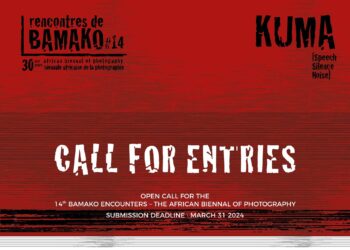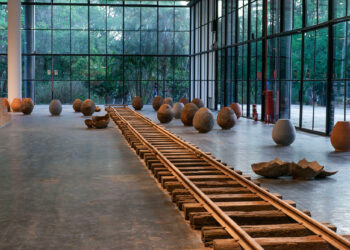Addressing the history and temperament of the city of Liverpool – a call for ancestral and indigenous forms of knowledge, wisdom and healing
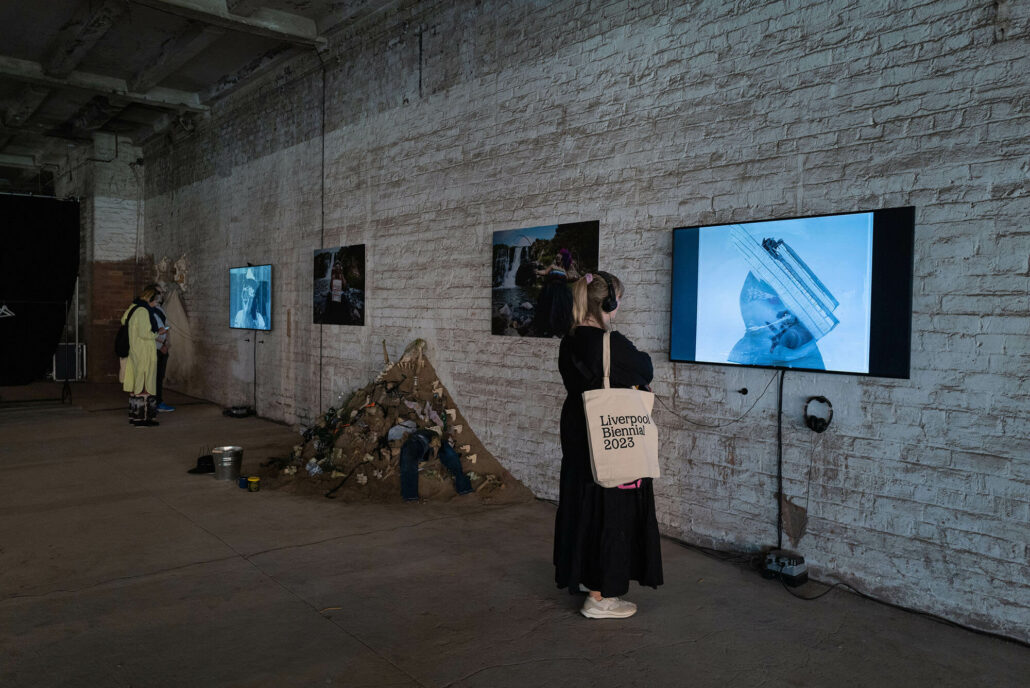
Albert Ibokwe Khoza, The Black Circus of the Republic of Bantu, 2023. Installation view at Tobacco Warehouse. Courtesy of Liverpool Biennial. Photographer: Mark McNulty
Liverpool a key location in the trade of enslaved people and a city that built itself through each ‘merchant’ ship. Khanyisile Mbongwa is the appointed curator of the Liverpool Biennial 2023 entitled ‘uMoya: The Sacred Return of Lost Things’. The Biennial addresses the city of Liverpool’s history and temperament; it calls for ancestral and indigenous forms of knowledge, wisdom, and healing. In the isiZulu language, ‘uMoya’ means spirit, breath, air, climate, and wind. It draws a line from the ongoing Catastrophes caused by colonialism towards an insistence on being truly Alive, pulling threads from East and Southern Africa, East and South Asia, North and South America, the Middle East, Oceania, and Europe.
The visual identity for ‘uMoya: The Sacred Return of Lost Things’ comprises lines, shapes and marks. In the 19th and early 20th centuries, Liverpool emerged as the world’s largest cotton market, holding the largest single stock worldwide. It was a period in the city’s history when economic prosperity depended upon the enforced movement of people, enslavement, trade and labour.
Julien Creuzet
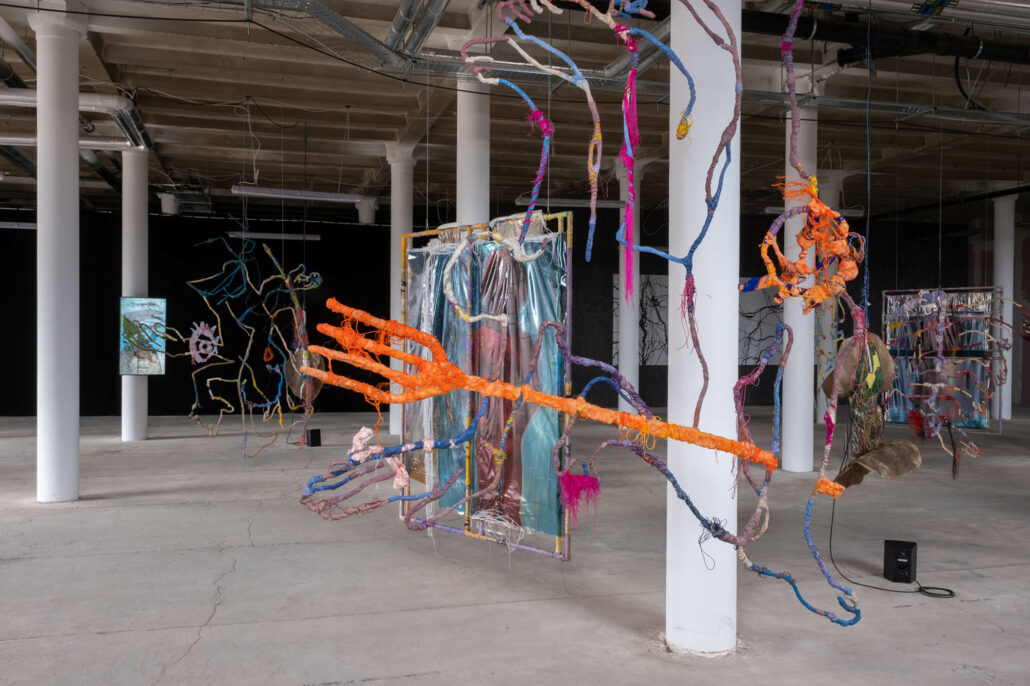
Julien Creuzet. Liverpool Biennial 2023 at Tobacco Warehouse. Courtesy of Liverpool Biennial. Photographer: Mark McNulty
Julien Creuzet presents a series of suspended abstract forms and intricate sculptures to create a complex installation that threads together a range of source imagery, including historical African sculptures, abstracted landscapes and compositions inspired by engravings and paintings. Addressing Creuzet’s relationship to his ancestral home of Martinique, the diasporic experience, and the history of French colonialism. The sculptural forms and layered images function as an intimate and powerful discovery of many worlds brought together.
Albert Ibokwe Khoza

Albert Ibokwe Khoza, The Black Circus of the Republic of Bantu, 2023. Liverpool Biennial 2023 at Tobacco Warehouse. Courtesy of Liverpool Biennial. Photographer: Mark McNulty
Albert Ibokwe Khoza’s live offering, ‘The Black Circus of the Republic of Bantu’ (2022), exposes the violent and shameful legacy of ethnological expositions (such as human zoos and exhibitions), popular in Western society between the 1870s and 1960s. The work investigates the impact of the imperial and colonial gaze on Black bodies, how it sits within Black bodies today, and how it might be remedied. By examining the ongoing pain of historical and continuing racism, the artist creates a space for collective healing and an opportunity for dignity to be reclaimed.
Binta Diaw
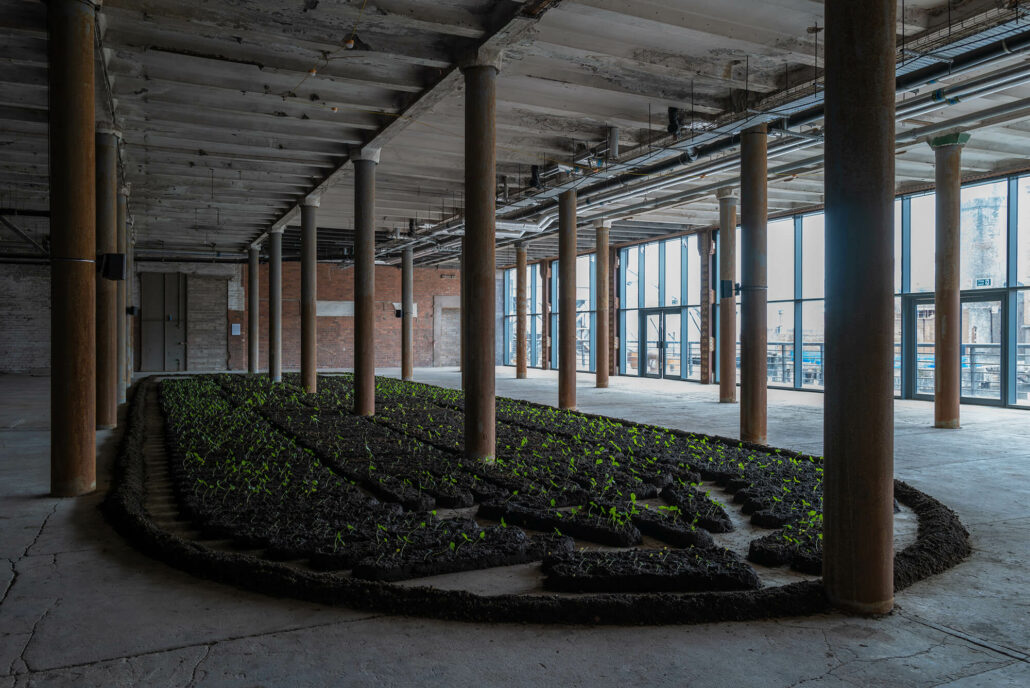
Binta Diaw, Chorus of Soil, 2023. Liverpool Biennial 2023 at Tobacco Warehouse.Courtesy of Liverpool Biennial. Photography by Mark McNulty.
Drawing on the artist’s interest in hidden histories and archival material, Binta Diaw’s reimagining of her installation ‘Chorus of Soil’ (2023) uses soil and seeds to map an 18th-century plan of the Brooks slave ship. Between 1782 and 1804, the Brooks departed from Liverpool to the West Coast of Africa, carrying over 5000 enslaved people to plantations in the Caribbean. Diaw references the plantation and the worked ground but transforms the narrative, reclaiming the labour of tending to the land and reinterpreting it as a productive, fertile space and emancipatory act.
Isa do Rosário

Isa do Rosário, Dança com a Morte no Atlântico (Dance with Death on the Atlantic Sea), 2013-2023. Liverpool Biennial 2023 at Tobacco Warehouse. Courtesy of Liverpool Biennial. Photographer: Mark McNulty
In creating her textile works, a spiritual conversation leads Isa do Rosário with Orixás (pronounced ‘oh-ri-shas’). According to Candomblé, an African religion that developed in Brazil during the 19th century, Orixás are believed to be ancestors who have been deified and represent the forces of nature. This piece, entitled ‘Dance with Death on the Atlantic Sea’ (2013-2023), represents life and death at the bottom of the sea. The artist uses small black dolls to represent Black people and their bodies, a memorial to all those who lost their lives during the Transatlantic Slave Trade. The work creates a meditation space that, via the Orixás, hopes to offer safe passage for the souls that linger in the ocean’s depths.
Torkwase Dyson
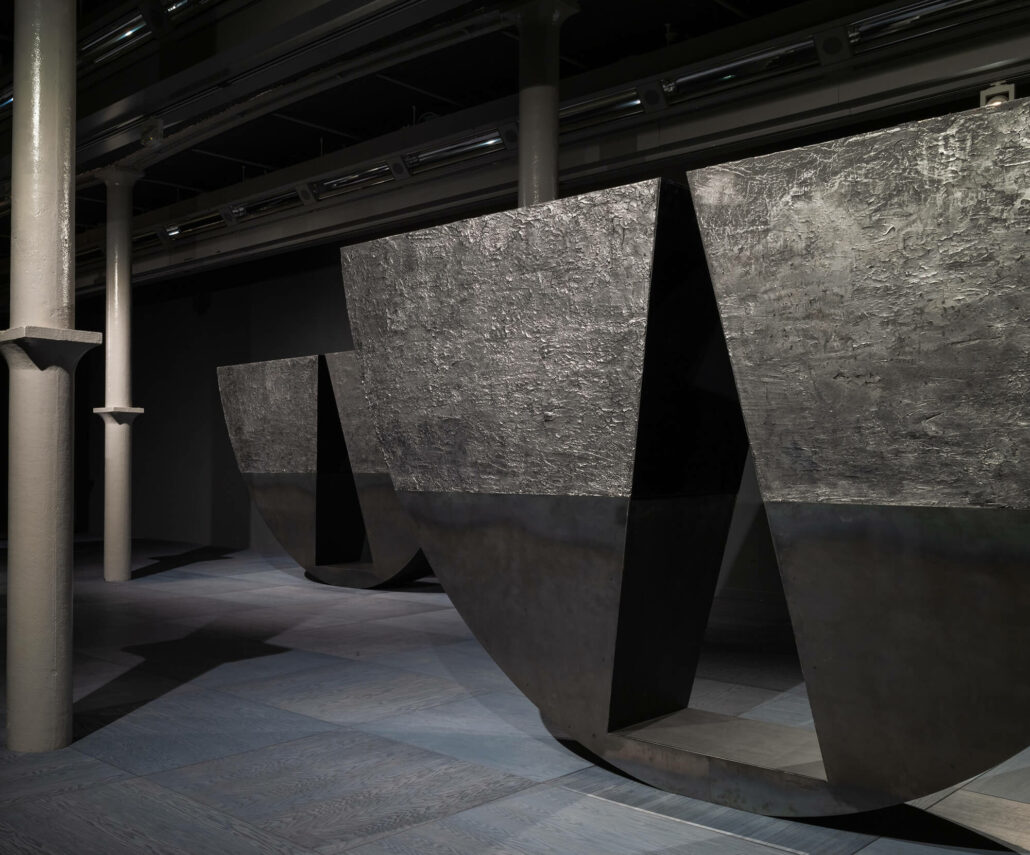
Torkwase Dyson, ‘Liquid a Place’, 2021. Liverpool Biennial 2023 at Tate Liverpool. Courtesy of Liverpool Biennial. Photographer: Mark McNulty
Torkwase Dyson’s abstract work ‘Liquid a Place’ (2021) comprises three striking structural objects which appear static and fluid simultaneously. The curved constructions are excavated by triangular voids within their centres, signifying a gateway, a shelter, or the sailing route upon which 2.4 million enslaved Africans lost their lives. The piece is in direct conversation with the dark histories of the water and docks surrounding Tate Liverpool – Britain’s first commercial wet dock was constructed in 1715 to service and expedite the Transatlantic Slave Trade. In this work, Dyson presents water as a simultaneous space of resistance, terror, conflict, pollution, oppression, refuge, extraction and liberation, particularly for Black and Brown bodies.
Francis Offman
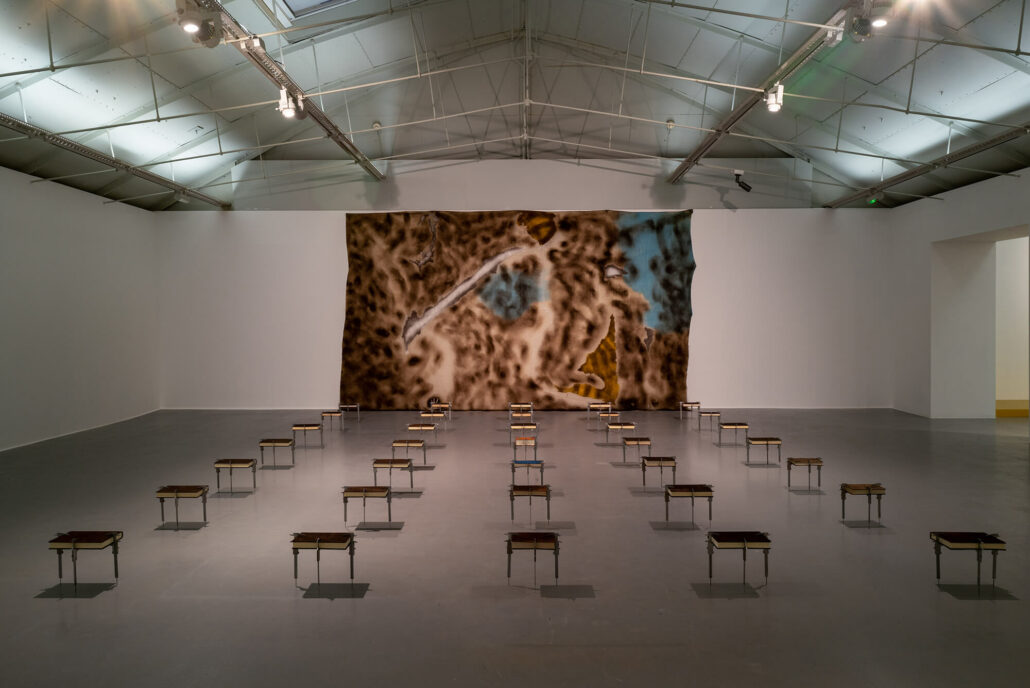
Francis Offman, ‘Untitled’, 2019-23. Liverpool Biennial 2023 at Tate Liverpool. Courtesy of Liverpool Biennial, Herald St, London; and P420, Bologna. Photographer: Mark McNulty
Francis Offman proposes a meditation on the Rwandan genocide, an intimate reflection on conveying history’s violent narrative through objects of personal connection. ‘Untitled’ is centred around a Bible which accompanied her as she fled the country with her family following the onset of the Rwandan Civil War. The floor is filled with books; each delicately held up by callipers – instruments used by Belgian colonisers to measure the facial features of Rwandan people and classify them into racial groups. This immense violence is juxtaposed against the daily pleasure of drinking coffee – a major export of Rwanda – with repurposed grounds spread on the fabric and covering the books.
Nolan Oswald Dennis
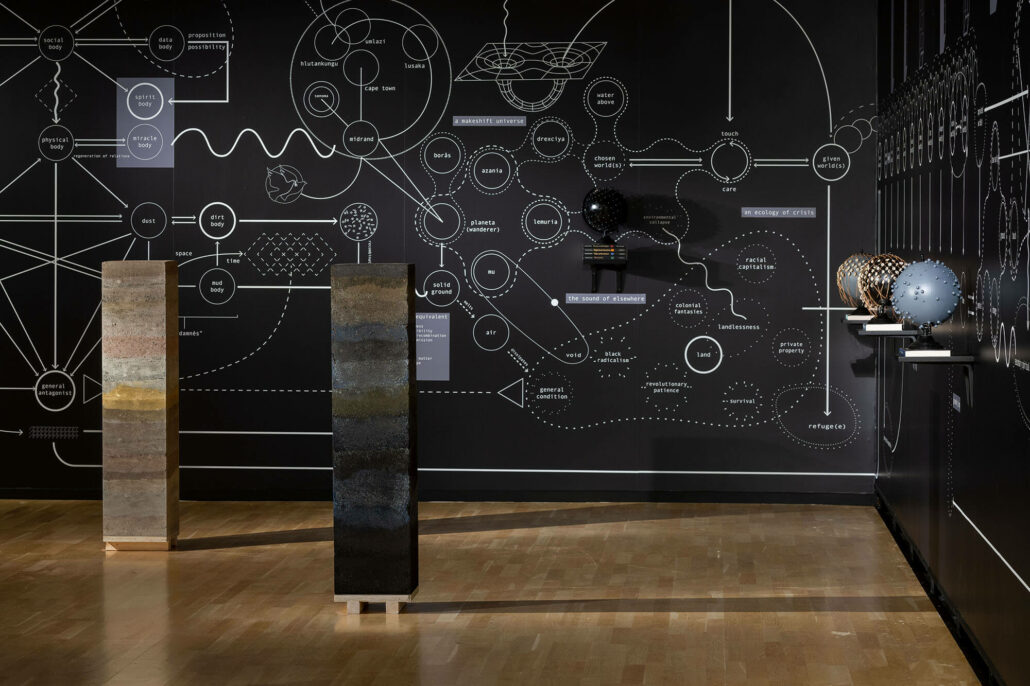
Nolan Oswald Dennis, xenolith field (chart), 2021. Courtesy the artist and Boras Konstmuseum. Photographer: Hendrik Zeitler
Nolan Oswald Dennis’ work ‘No conciliation is possible (working diagram)’ (2018 – ongoing) is next in their series of installations consisting of map-like wall diagrams and a shifting selection of drawings and objects which amplify the diagrams’ contents. Dennis explores the hidden structures that determine the limits of our social and political imagination. Within the diagram, the meanings of terms such as ‘welcomed and unwelcomed’, ‘apology’, ‘land’, ‘country’, ‘home’, ‘dream’, ‘ancestor’, ‘inheritance’ and ‘healing’ are complicated by their shared and unshared meanings. Meanwhile, using terms like ‘reconciliation’, ‘reparations’, ‘repatriation’, ‘regeneration’, ‘compensation’ and ‘justice’ can be seen as a condition and limitation of imagining a world beyond our reality. In particular, the work examines how decolonisation, colonial compensation and conciliation exist throughout history, in the present and future.
Pamela Phatsimo Sunstrum

Pamela Phatsimo Sunstrum, Mumbo Jumbo and The Committee, 2022. Liverpool Biennial 2023 at Tate Liverpool. Courtesy of Liverpool Biennial and Galerie Lelong & Co, New York. Photographer: Stuart Whipps
In ‘Mumbo Jumbo and The Committee’ (2022), Pamela Phatsimo Sunstrum explores the conflicting demands faced by the artist in pursuit of home and wholeness – the intrinsic expectations of family and community, with the demands and limitations imposed by whiteness. Through drawing, animation and bespoke furnishing inspired by Victorian design aesthetics, Sunstrum looks at how our cultural identities are often tied to our environments, to the expectations of others and imposing systems of class and race inequality.
Shannon Alonzo
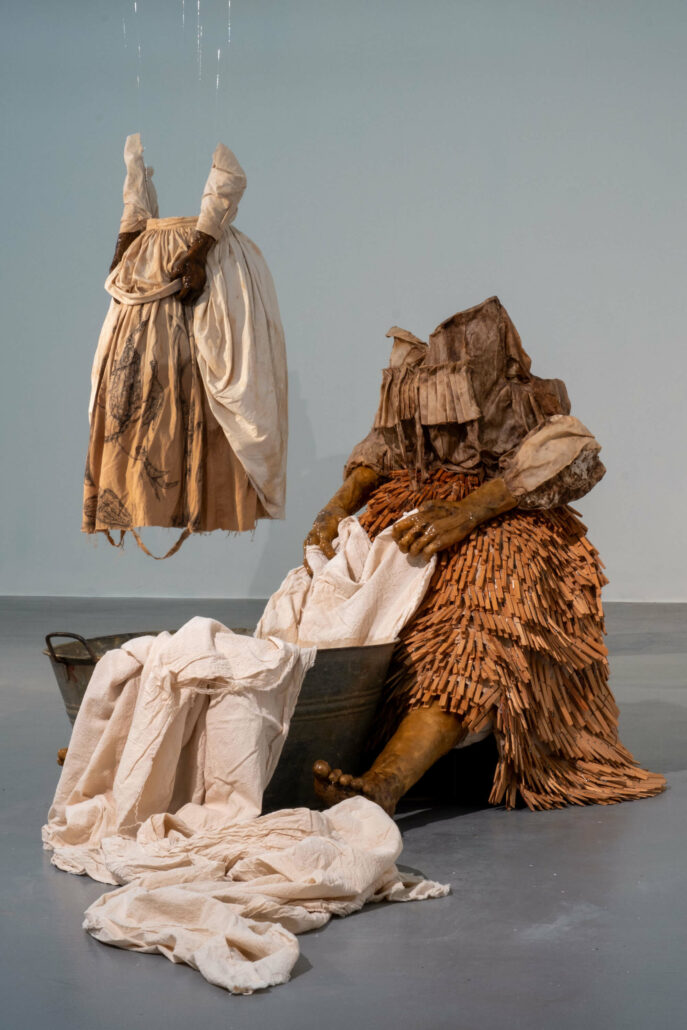
Shannon Alonzo, Lowest Hanging Fruit and Washerwoman, 2018. Liverpool Biennial 2023 at Tate Liverpool. Courtesy of Liverpool Biennial. Photographer: MarkMcNulty.
Shannon Alonzo aims to connect or draw a thread between past and present. She etches, stitches, draws and moulds to make the rich archive of the Caribbean community more tangible. She attempts to counteract years of historical erasure and remnants of colonial legacy, which often obscures progress towards collective belonging and a deeper understanding of the self for Caribbean people. The artist questions how our everyday choices are often informed by our history and Alonzo’s attempt to get to know her ancestors through the work of her own hands, which silently move alongside theirs across time.
Lungiswa Gqunta

Lungiswa Gqunta, Sleeping Pools–Brewing, 2023. Liverpool Biennial 2023 at Cotton Exchange. Courtesy of Liverpool Biennial. Photographer: Mark McNulty.
Lungiswa Gqunta is interested in histories of displacement and how colonialism, slavery and Apartheid shape and inform displacement. Her work is fractured with the cracks that rupture the underlying structure of South African society. Rather than build upon this rocky terrain, Gqunta pieces together the fragments of her lived experiences – those of her community’s collective memories – and distils them into their most essential materials, reconstructing the socio-political landscape. Gqunta questions what it means to rest in the tenuous divide that separates public and private domains in South Africa, subsequently creating a ‘third space’ where the luxury of a suburb and the perceived threat of a township coincide.
Belinda Kazeem-Kaminski

Belinda Kazeem-Kamiński, Respire and Openings. Liverpool Biennial 2023 at FACT Liverpool. Courtesy of Liverpool Biennial. Photographer: Mark McNulty
Belinda Kazeem-Kaminski’s Respire (Liverpool) (2023) references the precarity of Black breathing and proposes breath as a means of individual and collective liberation. Accompanied by Keep On Keepin On (for Nile) (2023), a soundscape created in collaboration with sound-artist Bassano Bonelli Bassano, this video work is committed to giving space to Black breathing to expand and exist freely. By positioning breath as a somatic response to violence but also to pleasure and connection, the works investigate breath as a compass to guide along the precarious line between catastrophe and aliveness.
David Aguacheiro

David Aguacheiro, Take Away, 2018. Liverpool Biennial 2023 at Open Eye Gallery. Courtesy of Liverpool Biennial. Photographer: Mark McNulty
David Aguacheiro’s photographic installation considers the ongoing extractivism (the removal of large quantities of raw or natural materials, particularly for export) of oil, timber, sea life and other essential natural resources from the artist’s home country of Mozambique and its devastating impacts. By centring people through his poignant portraits, Aguacheiro suggests that the repercussions of this violence are complex, deep-rooted, and layered. The artist presents people stripped of their resources, clothes, dignity, and identities. The extraction is extended beyond that of the land to include culture, place, tradition, language, religion, worth, and self.
Rahima Gambo
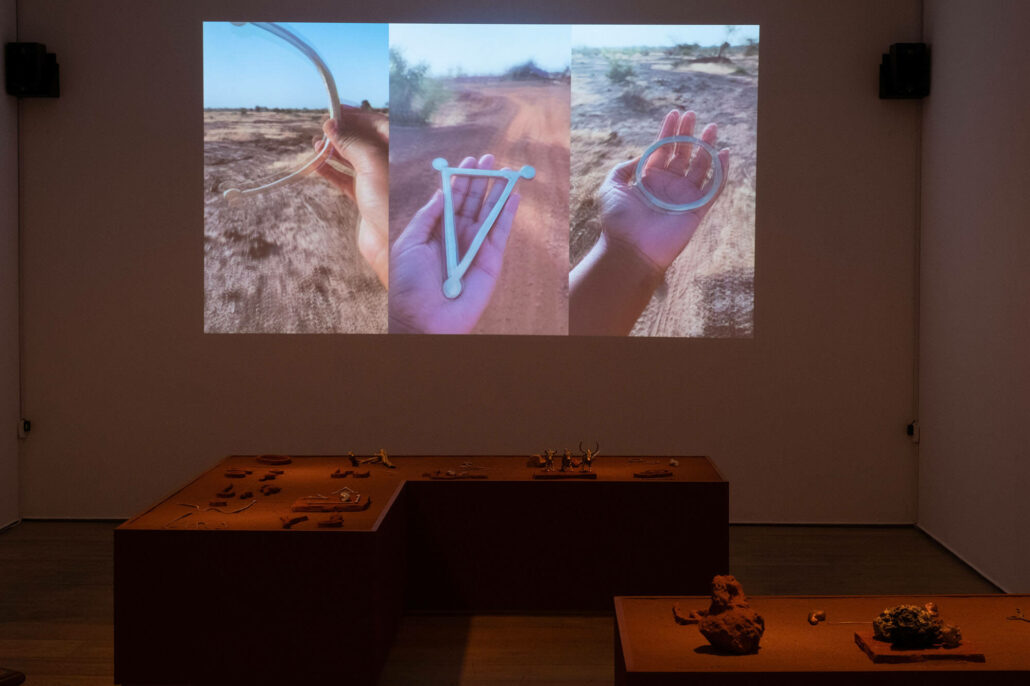
Rahima Gambo, Nest-works and Wander-lines and Instruments of Air, 2021. Liverpool Biennial 2023 at Open Eye Gallery. Courtesy of Liverpool Biennial. Photographer: Mark McNulty
Rahima Gambo employs walking as an artistic practice, using movement as a meditative and creative process to weave a visual story. ‘Nest-works and Wander-lines’ (2021) and ‘Instruments of Air’ (2021) explore the origins of language, embodied and multisensory communication, and speculative storytelling. With a background in photojournalism, here Gambo proposes an alternative to the documentary storytelling form, focusing on sensing rather than seeing and experimenting with new forms of non-verbal language. The works reject standardised and normative forms of communication, using movement, symbols, signs, gesturing, tracing and silence as preferred modes of understanding the world. Suspended in the centre of the gallery, Sandra Suubi’s ‘Samba Gown’ is a statement of resistance and imagines and re-enacts the Ugandan independence ceremony of 1962 as a wedding ceremony. The work highlights the transactional relationship between former colonies and their colonisers. The photographs displayed around the gallery document the wearing of the gown in various rubbish dumps in Kampala, Uganda. Comprised of plastic waste, the gown comments on plastic pollution as one of the major aftermaths of colonialism – Uganda receives thousands of tonnes of plastic waste from wealthy nations each year.
Charmaine Watkiss

Charmaine Watkiss, Witness, 2023. Liverpool Biennial 2023 at Victoria Gallery & Museum. Courtesy of Liverpool Biennial. Photographer: Mark McNulty
Charmaine Watkiss’ work forms what she calls ‘memory stories’, visual representations of her research into the African Caribbean diaspora mapped onto life-sized figures. The artist’s work traces African ancestral traditions that survived the Transatlantic crossing; the stories, rituals, and customs have become part of Caribbean culture. ‘Witness’ (2023) depicts two deities who share tales of courage in the face of adversity.
Nicholas Galanin
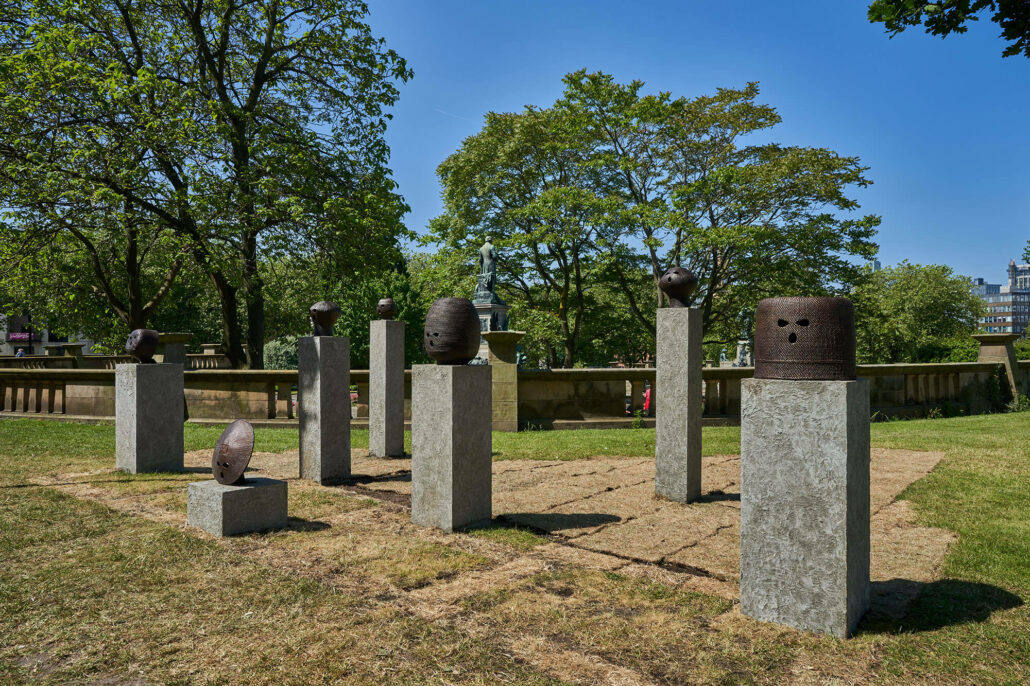
Nicholas Galanin, Threat Return, 2023. Installation view at St Johns Gardens, Liverpool Biennial 2023. Courtesy Liverpool Biennial. Photographer: Rob Battersby
Nicholas Galanin presents ‘Threat Return’ (2023): a gathering of overturned, cast-bronze handwoven baskets modified to resemble burglary masks. Galanin references museum displays of Indigenous North American, and African basketry and cinematic portrayals of thieves via ski mask cut-outs incised into each basket, contemplating the commodification, reproduction, theft, and imitation of indigenous cultural traditions. The work reflects what is considered theft, a meditation on the reflexivity of threat and the return of energy and cultural property. Galanin insists on the persistence of Indigenous connection to land and culture, which is embedded in bodies, memories, traditions, objects and languages.
Ranti Bam
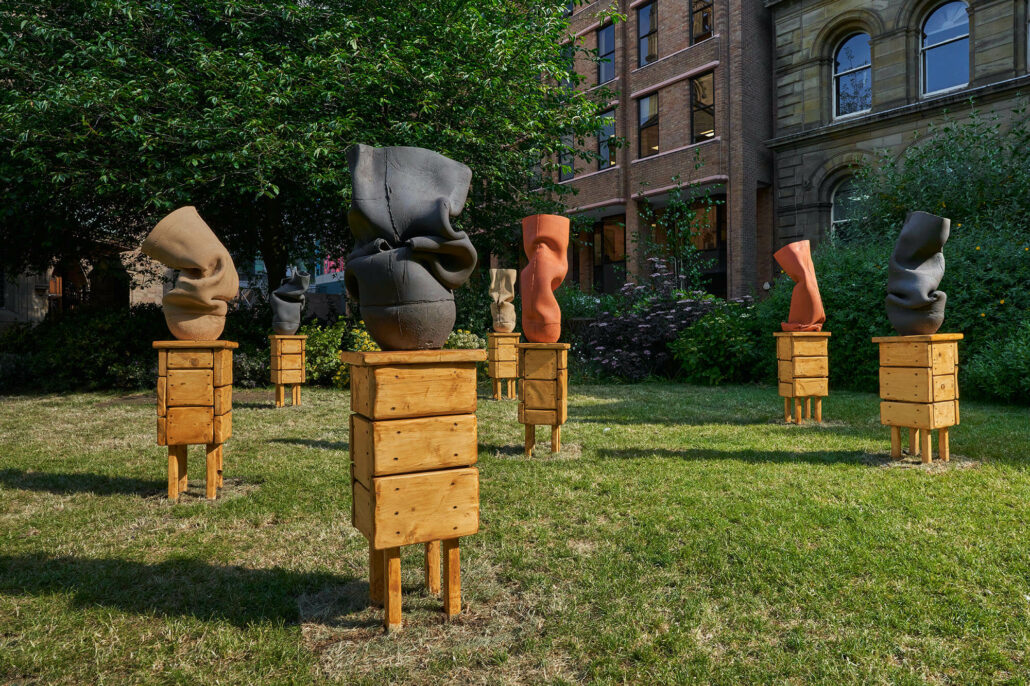
Ranti Bam, Ifas, 2023. Installation view at St Nicholas Church Gardens, Liverpool Biennial 2023. Courtesy Liverpool Biennial. Photographer: Rob Battersby
Ranti Bam offers a new meeting point for visitors to gather in mediation, contemplation, and discourse. Inspired by clay’s profound curative and narrative powers, Bam presents seven new sculptures from her ‘Ifa’ series (2021-23). Through an intimate and time-sensitive creation process, Bam explores themes around fragility and vulnerability, intimacy and care, feminine labour and strength. The artist proposes clay as a medium for understanding human inseparability from our environment. The title ‘Ifa’ references the Yoruba word ‘I-fàá’, meaning ‘to pull close’, and ‘Ifá’, the Yoruba divination system.
Rudy Loewe

Rudy Loewe, The Reckoning, 2023. Installation view at Liverpool ONE, Liverpool Biennial 2023. Courtesy Liverpool Biennial. Photographer: Rob Battersby.
Rudy Loewe presents a new large-scale installation based on the artist’s painting ‘February 1970, Trinidad #1’, which depicts Moko Jumbie (a stilt walker) and other Carnival mas players (participants who wear masquerade costumes and march in the parade) coming to the aid of the people at a moment of Black Power revolution in Trinidad and Tobago. ‘The Reckoning’ (2023) transports these spirits to the site of The Old Dock, where they confront Britain’s colonial legacy and its contemporary reverberations. Loewe aims to visualise Black histories and social politics through their work, particularly focusing on a critique of Britain’s role in suppressing Black Power organising in the English-speaking Caribbean during the 1960s and 70s.
Lorin Sookool

Lorin Sookool, Woza Wenties!, 2023. Liverpool Biennial 2023 at St Luke’s BombedOut Church. Photographer: Mark McNulty.
Lorin Sookool’s ‘Woza Wenties!’ (2023) uses dance movement to trace and unpack the violent erasure of her Black identity during her schooling in South Africa. Through a creative process that engages with the political through a very personal, embodied experience, Sookool embarks on a journey of remembering, restoration and repositioning her Brown body. The artist uses dance to examine the complex and nuanced conditions of her ‘Colouredness’, a specific experience of Blackness within the South African socio-historical, political and cultural context. By interpreting the dancing body as a previously colonised state, Sookool intends to understand her erasure by deconstructing the colonial projects undertaken in many South African schools post-1994. Using dance movement as a tool to symbolise a body under duress, Sookool references colonial and modernist systems of dance techniques and uses improvisation as a means to decolonise the body.
Unmute Dance Theatre
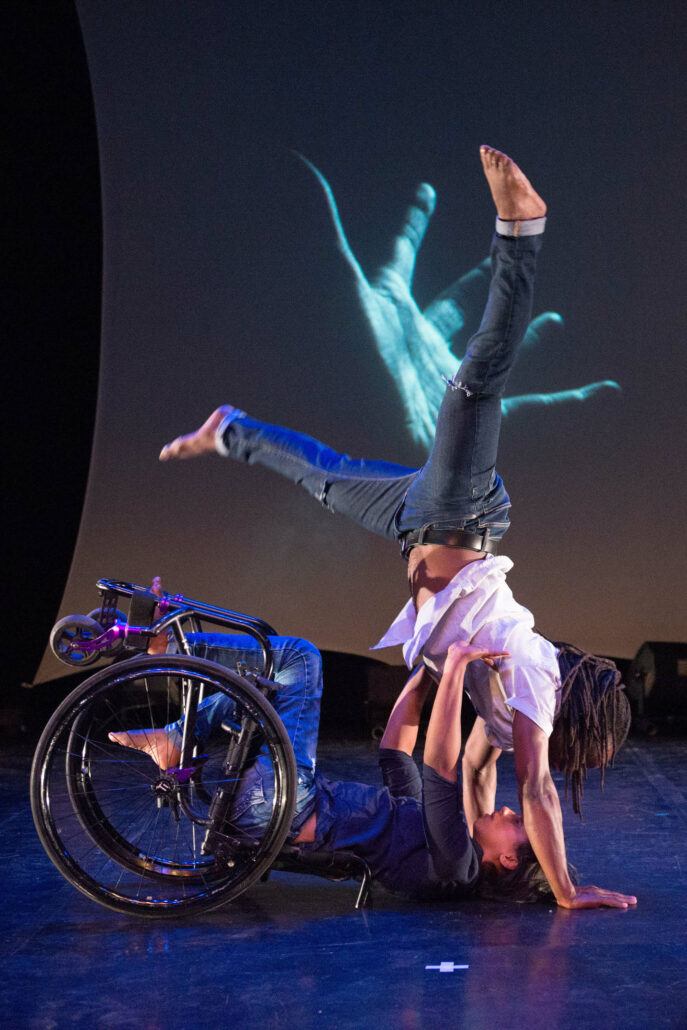
Unmute Dance Company, Access Me, 2017. Courtesy of the Collective. Photographer: Val Adamson
Unmute Dance Theatre is an integrated company of artists with mixed abilities and disabilities who use physical theatre and contemporary and integrated dance to promote awareness around accessibility, integration and inclusion of Disabled people in mainstream society. Through this practice, the artists explore what they want to ‘unmute’; feelings, perceptions, social norms and expectations, while simultaneously deconstructing what society perceives as dance. Bringing their bespoke choreography style derived from South African Sign Language, Unmute explores the body as a vessel for alternative, more accessible forms of communication that transcend spoken or written language. Like the wind in ‘uMoya’, a form of language holding histories and ancestral tales, the body is an unmuted language, speaking in abstract symbols of its lived experiences.
The Liverpool Biennial takes place from the 10th of June until the 17th of September, 2023. The Liverpool Biennial is the largest of its kind in the UK and is free to attend. Immerse yourself in the works of distinguished UK and Global South artists, exhibited in galleries, museums, public spaces, and online – an extraordinary opportunity to discover the city and explore the world of art.
For more information, please visit the Liverpool Biennial.

